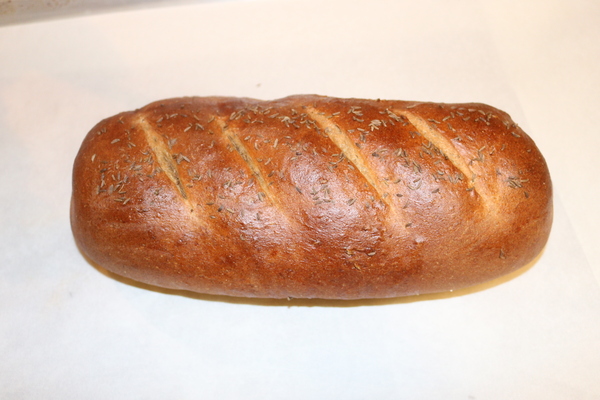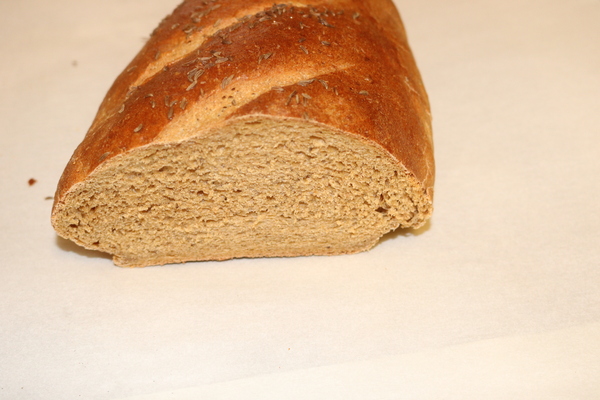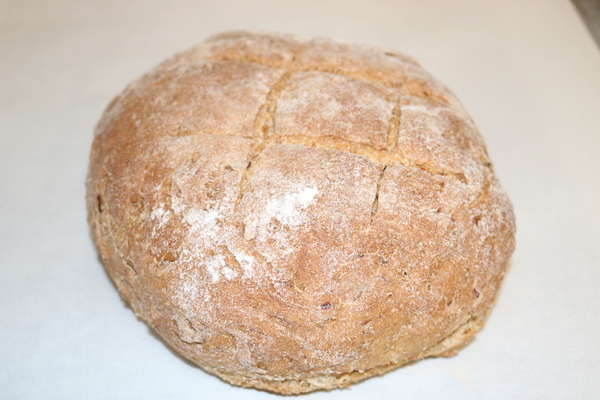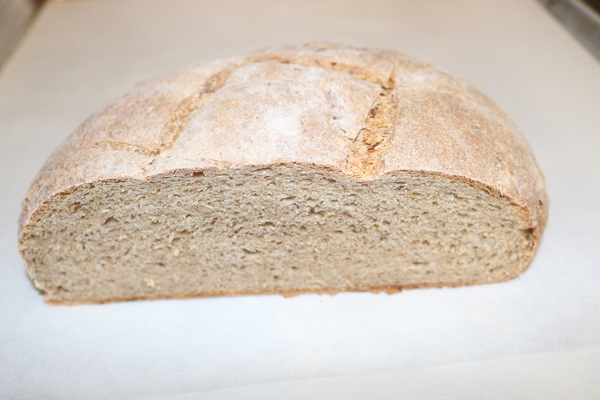Forum Replies Created
-
AuthorPosts
-
I saw something on an episode of Chopped this week that I haven't seen very often on competitive cooking shows.
In the dessert round one of the competitors cut his hand badly with less than two minutes in the round. He hadn't finished plating all four of his dishes and leaving ingredients off the plate will often get you chopped. While the medic was attending to him, the clock kept counting down. With under 30 seconds to go, he was still being attended to, so his opponent finished plating his foods for him. (All he had to do was move two bowls of ice cream onto the plate.)
As it turned out, the guy who cut his hand won the competition, he almost certainly would have lost had his opponent not finished plating for him. I hope they invite the guy who lost back for another competition, sportsmanship deserves recognition.
Once you've got a starter well-established, it can be pretty tolerant. I know people who've forgotten they had a starter and found it at the back of a refrigerator shelf weeks or months later and it bounced back just fine.
I'm in the last few days of building my rye starter, so it hasn't gone in the fridge yet. It's pretty active at this point, I refreshed it around 10 PM last night and by 10 AM this morning it had doubled. It has an interesting but fairly pleasant sour aroma.
I think if you've got a week or so when you'll be at home, you can probably build a rye starter using Ginsberg's protocol, then stick it in the fridge. A day or two before you're ready to bake, take a small amount of the starter, mix it with some rye flour and warm water, and let it sit on the counter for a day, it should be ready to go.
I've saved up all the discards, they're in the fridge. I'm planning to use them for some of the Ginsberg recipes. (Right now I'm thinking of trying the Munich Penny rolls next, I've ordered some rye malt and will toast it to produce red rye malt--lightly toasted).
There's no beer in the Old Milwaukee bread, though I think there are a few of Ginsberg's recipes that do use beer in them. I'm not a beer drinker, but I think that Old Milwaukee beer is still on the market.
Making 78 rye recipes is likely to produce rye bread fatigue here, so I'm thinking I may do 2 or 3 then take a break of a week or two. I may have to try a few new non-rye recipes just for a change of pace, too. Maybe I'll try Hamelman's wild yeast raisin bread recipe again, last time I got the wrong kind of mold on the top of the raisin water and had to throw it out. Debbie Wink says that sometimes happens, raisins can have several types of mold spores on them, including Botrytis cinerea, the grey mold responsible for 'noble rot' in Sauternes dessert wines.
King Arthur used to sell a 'deli rye' pan, with sides that sloped out sort of like a trapezoid, but it looks like they no longer have it. I thought it was a Chicago Metallic pan, but they don't seem to have it on their site, either. Specialty pans come and go, I guess, I've got several that nobody seems to carry any more. (And I've got two large glass pans that I broke the lid to one of, but the French maker no longer makes that size.)
The main reason I bake most of my breads freeform is that I prefer a crust that has some body to it.
Report on Old Milwaukee Rye (The Rye Baker pps 98-101):
The recipe made two loaves. Although Ginsberg recommends a football shaped loaf, I made more of a cylindrical one, because that way the slices are more uniform in size. The loaves are about 11 inches long with a cross section of about 5 inches by 3 inches. The finished loaf weighs 696 grams or about 24 1/2 ounces.
This dough came together quickly and looked and felt quite a bit like gingerbread, not at all sticky. It rose well, though a little slow, that might have just been the kitchen temperature. It baked a little faster than the recipe called for, but that may have been due to how I shaped it.
The caraway seeds on the outside didn't stick very well, I may not have had enough egg in the egg wash. And I remembered why I generally don't put caraway seeds on the outside, they get very hard and stick in between my teeth.
The bread is fairly dark on the inside, due in large part to the molasses. There's a noticeable aftertaste from the molasses, but it is not an unpleasant one. I think that may fade a little over time, when the loaves came out of the oven the molasses odor was much stronger.
We think the bread is very tasty as a sandwich bread, it would probably make excellent Reubens, too. It reminds me a bit of the rye bread I get in the Amish store in Iowa.
It toasts very well and I think it would pair quite well with stronger toppings, like an apple butter. I think there's a good chance I'll make this bread again.
Followup: It tastes even better on day 2.
-
This reply was modified 5 years, 9 months ago by
Mike Nolan.
-
This reply was modified 5 years, 9 months ago by
Mike Nolan.
Attachments:
You must be logged in to view attached files.We had sandwiches on the Old Milwaukee rye bread, hers was pastrami mine was corned beef. I also had some peas.
I consider parsnips the missing secret ingredient in chicken soup, so I always put in a couple of parsnips when making chicken broth or stock. Parsnips add a sweetness to the liquid. Before sugar beets, parsnips were sometimes used to sweeten things
Looks like it is very similar, it uses a sponge, has molasses, an oil (Ginsberg uses butter), and an egg. Ginsberg has you make football-shaped loaves, I made ones that were more of a cylinder so that the slices will be about the same size, which is better for sandwiches. The loaves are cooling, the molasses smell is still pretty strong, I'm hoping it fades a bit. The caraway seeds aren't sticking to the outside very well, I may not have had enough egg in the egg wash.
When we were living in Chicago in the 70's, there was a packaged rye bread at the store that was a fairly ordinary rye bread, until you put it in the toaster. Then something magical happened, probably a result of the Maillard Reaction. It developed a complexity that was completely absent before toasting. I would toast and eat several slices at a time. I still consider the toast test to be the ultimate way to judge rye bread.
Report on Sauerkraut Bread (The Rye Baker pps 212-214):
This recipe made two loaves about 7 inches in diameter and 3 inches high. The baked weight was 787 grams (27 3/4 ounces.)
I wound up adding a bit more flour than the recipe called for, I think I mis-measured the water, but the dough came together fairly well. However, the dough weight was still a little less than what the recipe suggested, so maybe I worked less flour into the dough during shaping.
It slices better after sitting overnight.
I didn't have Polish sauerkraut so I used what I had, the kraut isn't overly assertive but it does add to the aroma of the bread when toasting it and the flavor is reminiscent of sauerkraut that has been cooked with sausage.
I tried it in a Reuben sandwich, the flavor of the baked sauerkraut clashed a bit with the raw sauerkraut, and I think the biggest challenge with this bread might be figuring out what foods pair best with it.
It tastes good toasted with a little butter, but the sauerkraut flavor probably wouldn't pair well with things you normally spread on toast, like jams. I probably would not make this bread unless I had a specific meal I wanted to make that the sauerkraut taste would pair with.
For comments on the preparation of this recipe, see Sauerkraut Rye Comments
Followup: I tried a slice with some cheddar cheese spread on it today, it was very good. Either the sauerkraut has mellowed or it pairs quite well with the cheese spread.
-
This reply was modified 5 years, 9 months ago by
Mike Nolan.
-
This reply was modified 5 years, 9 months ago by
Mike Nolan.
-
This reply was modified 5 years, 9 months ago by
Mike Nolan.
-
This reply was modified 5 years, 9 months ago by
Mike Nolan.
Attachments:
You must be logged in to view attached files.Sometimes the best quiz questions are things we all think we know.
Great height, Len.
I'm making the Old Milwaukee Rye bread from TRB today. (No, it doesn't use beer.)
Parsnips get very soft when cooked, parsnip mash is a common side dish in England.
We had reubens. My wife didn't want to wait until the sauerkraut rye bread was cool enough to slice, so she had hers on some marbled rye bread from the freezer.
I'll comment more on the sauerkraut rye bread in the 'Coming Through the Rye' thread after I've taken some pictures.
I wonder which has more LAB, yogurt or buttermilk?
Having some idea of weight-to-measure equivalents for ingredients is very helpful in planning menus, shopping, and preparing meals. I'm told that at cooking schools like CIA they have students memorize long lists of equivalents and test them on their knowledge.
Most catered events like weddings serve food that is of at-best average quality. That's especially true if the food is brought in to the hall, the kitchens for hotel events tend to be slightly higher quality, but generally still not great. Part of it is that producing large numbers of meals served at the same time requires some compromises in the kitchen.
But there are exceptions. Years ago my wife went to a national conference for her sorority, at a hotel in Minneapolis. She said the meals were so good that when the chef came out at the last event, he got a standing ovation.
I've only been to one catered event that had a truly outstanding meal, it was the bar mitzvah dinner for the son of a business associate of my wife's father, held at the old Cafe La Tour Restaurant in Chicago, on the top level of a Mies van der Rohe designed high-rise on the shore of Lake Michigan just north of the Loop.
We lost count of the number of courses at around 10, and they were still bringing out additional rounds of desserts as we were leaving.
-
This reply was modified 5 years, 9 months ago by
-
AuthorPosts



